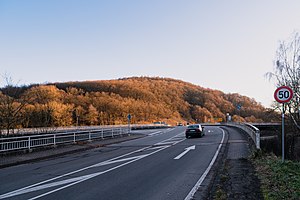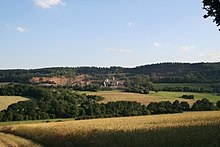Spiedmont
| Spiedmont | ||
|---|---|---|
|
View from the L132 road to Spiemont |
||
| height | 400.5 m above sea level NN | |
| location | Saarland , Germany | |
| Coordinates | 49 ° 26 '39 " N , 7 ° 9' 6" E | |
|
|
||
The Spiemont is a mountain between Oberlinxweiler and Niederlinxweiler , both districts of the district town of St. Wendel in the district of St. Wendel in ( Saarland ), on which there was a prehistoric fortification. The complex geological structure of the Härtling allowed next to each other clay and hard quarry and lime, coal and copper, sanguine and agate degradation.
Names
There are different interpretations of the name Spiemont. An early etymological attempt has it rooted in Roman-Latin with “spei mons”, which means “mountain with a viewpoint”. However, the former Saarland state curator Alfons Kolling preferred a Middle Latin name: Analogous to other site names (e.g. Litermont ), "-mont" (or "-munti") would be called fortified mountain with the prefix "Spie-" or “Spue-” from “specula”, which means “observatory” or “waiting”. As a result, Spiedmont got its name from its outstanding location as an observation point for the surrounding region.
Geographical location
In the literature, Spiemont is referred to as an "east-west-directed narrow bar between Ostertal and Bliestal". The mountain rises moderately in the east from a plateau that has been called "Ho (c) hfuhr" since ancient times, over which a Roman road ran from Trier to Strasbourg.
The Spiemont culminates at point 400.5 m above sea level. NN about 140 meters above the valley floor, then runs further west in a wavy skyline, tightens itself to an occasionally sharp ridge, forms the Schloßberg summit, widens again a little, and then with the opposite Steinberg a steep, narrow notch of the Bliestal which the locals used to call "Klaus". Geographers speak of the "Linxweiler gate". Here the river used to force its way through the hard Kuselit , for the construction of the Nahe Valley Railway between 1857 and 1860 and the new construction of the B41 around 1970, the Linxweiler gate was then widened.
history
Spiemont was first mentioned in a document in 1328. A document says that Count Johann von Saarbrücken sold the mountain Spuyemont to Archbishop Balduin von Trier and received it back as a fief. He promised not to damage the nearby St. Wendel fortress from the mountain. In 1355 Count Johann von Saarbrücken announced that he wanted to forego certain demands on the bishop, including "help with the building on the Spiemont mountain". And 38 years later, a citizen of Saarbrücken named "Hans von Spiemont" is called and from this it is concluded that the castle and lord of the castle are.
According to Kolling, the unusual appearance of the mountain, its shape, its rock, its minerals and the dodgy "cultural quality" made it an object of speculation. The earliest evidence of this is a report by the Saarbrücken office clerk JC Kilburger from 1632. The Ottweiler subject was asked by his Saarbrücken superior Joh. Andreae to investigate what the rubble and the Spiemont in general were all about. In his report, which was printed in “Genealogia Saraepontana” by Joh. Andrae in 1638, there are numerous references to Roman stone images. So it is said u. a .: "Uff on the other side of the mountain towards Oberlinxweiler, the old people have hacked out a lot of nicely hidden stones, of which you can still see a number of round stone pillars on Clossen Hansen Hauß."
Around 200 years later, the St. Wendel Historical Association, founded in 1836, carried out the first excavation on Spiemont. On the north-eastern mountain slope in the corridor "Auf Henschhof" Roman-era walls were excavated 150 feet, pieces of columns, a stone relief with a naked boy and a bird, a water pipe and coins from Claudius 11th to Licinius were also found. The excavation revealed that the building was probably destroyed by fire.
In 1891, at the eastern end of the Spiemont in Flur Kalkofen, another excavation of the remains of Roman settlements took place. The most important find was a well-preserved bathing pool from which a lead pipe with a bronze cap and a snap lock peeped out. In addition to “pots and bricks”, a statue made of sandstone was also excavated. Ten years later, in 1901, the Rheinisches Landesmuseum in Trier measured the walls of the Villa Henschhof again.
The last excavation was carried out in 1979 and 1980 in the area of the castle site. Kolling came to the conclusion that the ditch, ramparts and terrace systems that were found correspond to the usual scope of Celtic refuges and ramparts, and that the small finds also come from the late phase of the Latène culture . After the Celtic walls fell into disrepair, a refuge was built on their foundations in late Roman times to ward off Germanic attacks. This is supported by the spolia found, stones in second use. Apparently stones from cult and grave monuments were used to extract building blocks for the refugee castle. However, no medieval building fabric was found.
Say
According to legend, a golden carriage is buried on the Schloßberg, the handle of which a rooster can scratch free. Furthermore, there is said to be a "vault" carved into the rock in the mountain, which supposedly belongs to the medieval castle and into which an Oberlinxweiler boy is said to have gotten into before the First World War . This is probably a mining or mutation tunnel of the former copper mine.
Rock mining in Spiedmont
Since there was a Celtic refuge on Spiemont, the origins of rock mining in Spiemont probably go back to this time. The first modern evidence is from the time when Oberlinxweiler belonged to the Principality of Lichtenberg . In a request, the Oberlinxweiler lay judges asked Duke Ernst I of Saxe-Coburg-Saalfeld , in the "manorial forest called Spiemont, on the road from Oberlinxweiler to Niederlinxweiler, to be allowed to continue to use a place to break stones". This place was already assigned to them by the government at the time of the Prince of Saarbrücken. Ernst I. had the application rejected by the Lord Mayor of St. Wendel on the grounds that "a sinkhole could occur in the future and that too much productive area would be withdrawn from the forest".
The modern quarry then started in 1898 when the Oberlinxweiler teacher Brandt began quarrying rock in the Röhlenberg district. In 1906, the paving master Friedrich Reinshagen from Neunkirchen joined the quarry and bought it a year later. In 1919 Reinshagen sold the quarry to the company Pfalz-Saarbrücker Hartstein-Industrie AG in Landau in the Palatinate. Today the Pfalz-Saarbrücker Hartstein-Industrie AG belongs to the Basalt-Actien-Gesellschaft .
swell
- 100 years of rock mining. ed. from Basalt-Actien-Gesellschaft, Südwestdeutsche Hartsteinwerke, Kirn / Nahe 2002, p. 138 ff.
- Josef Dreesen: Quarry in Spiemont. In: The community bills of the home eggs, unknown sources from Oberlinxweiler. 1750–1870, Stadtmuseum St. Wendel, 2008, p. 101
- Alfons Kolling : On the archeology of Spiemont. In: Reinhard Schlindler on his seventieth birthday on April 7, 1982. Published in the Trier magazine for the history and art of the Trier region and its neighboring regions 45 (1982), pp. 45–63
- Wolf Schwingel: Heimatbuch Oberlinxweiler, a reading and source book on local history. ed. from the district town of St. Wendel, St. Wendel 1986



